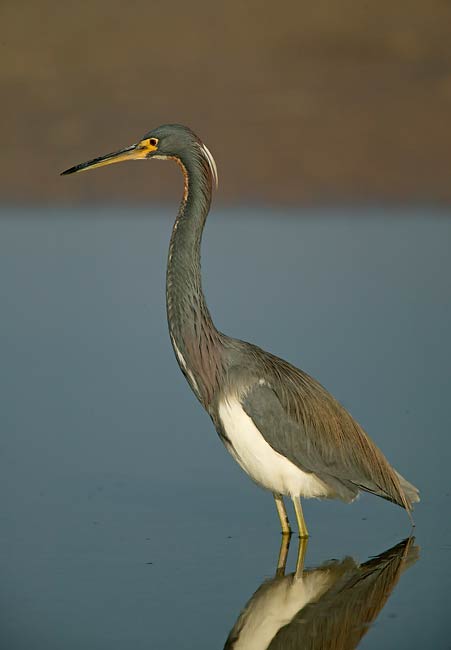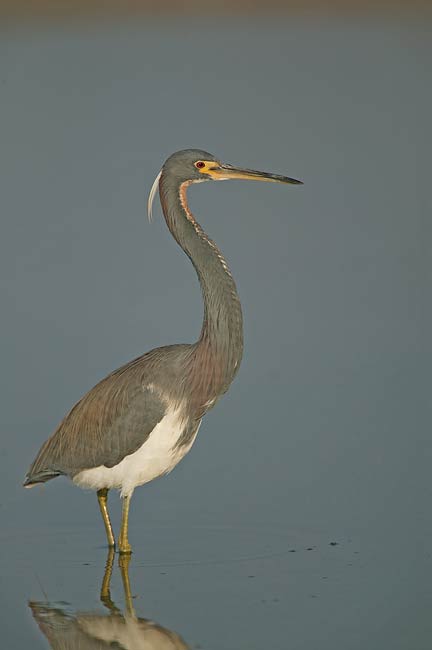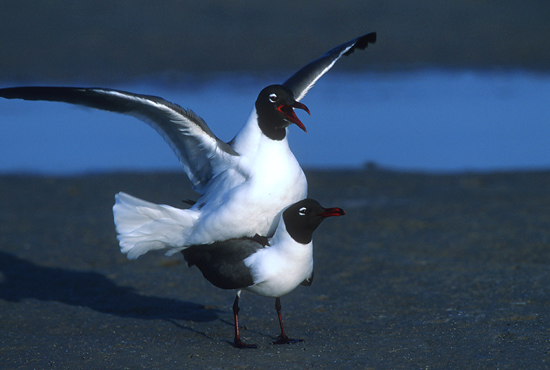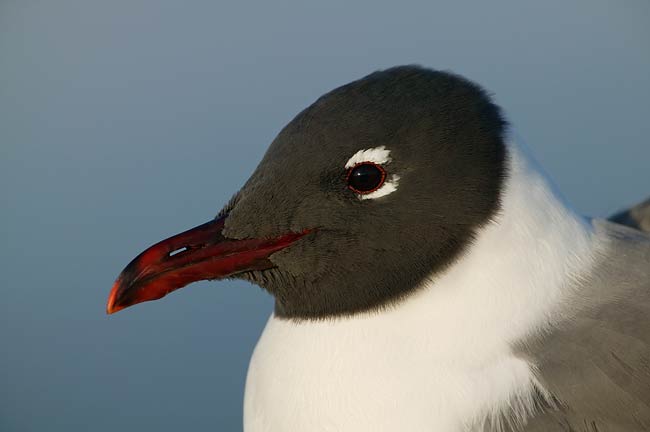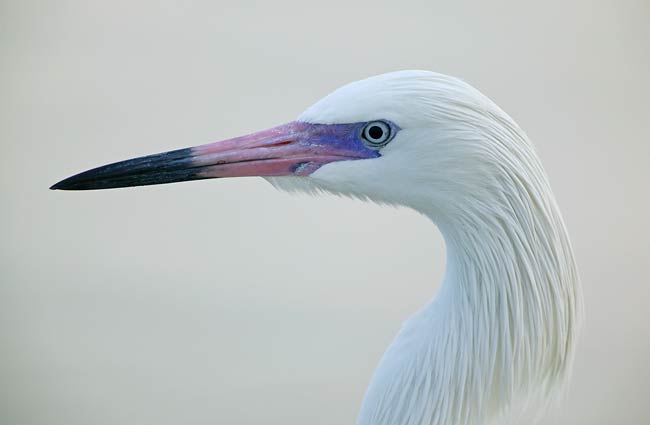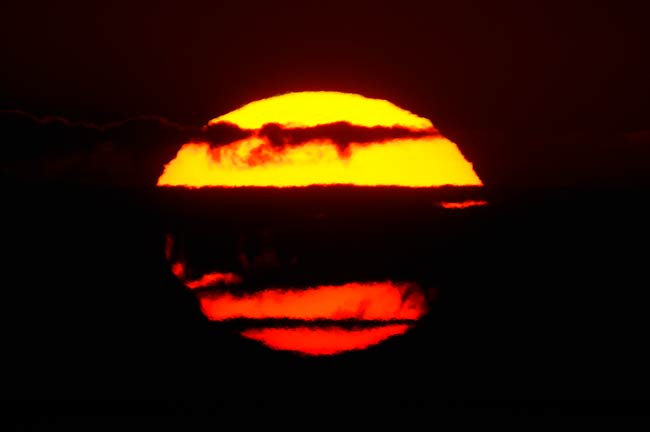LESSONS IN BIRD PHOTOGRAPHY
FORT DESOTO SMALL GROUP/INSTRUCTIONAL SLOTS OPEN: SAT APRIL 3
DESPERATELY SEEKING SINGLES: THE KENYA PHOTO SAFARI, AUGUST 2004
IPT UPDATES
Photo Theme: images from Fort DeSoto on the weekend of March 13-14.
LESSON #1
Tricolored Heron, Fort DeSoto Park, FL
Image copyright 2004 Arthur Morris/BIRDS AS ART
Canon EF 500m f/4 L IS lens with 1.4X II TC and EOS 1Ds digital camera. ISO 250
Evaluative metering: 1/2500 sec. at f/5.6
Here is an image of a beautiful bird that is sharp and perfectly exposed. And though the photo was made in soft early morning light it is simply not a good photograph. Why? The bird's head is turned well away from the film plane, and the far shoreline cuts the bird's neck just below the head. What to do: hit the delete key!
Tricolored Heron, Fort DeSoto Park, FL
Image copyright 2004 Arthur Morris/BIRDS AS ART
Canon EF 500m f/4 L IS lens with 1.4X II TC and EOS 1Ds digital camera. ISO 250
Evaluative metering +1/3 stop: 1/2000 sec. at f/5.6
This is a far more effective image of the same bird made within minutes of the first one. I waited for the bird to wade into the center of the pool, thus eliminating the far shoreline from the image, and then waited for the perfect head position. Many will ask, "Why cut the reflection, why not include the whole reflection?" First off, to do so would result in a totally different image, an image that would not reveal the plumage detail seen here. Second, and more importantly, unless the water is absolutely mirror-like, the image of the bird will always be much sharper than the image of the bird's reflection. To me, this gives such images a top-heavy look.
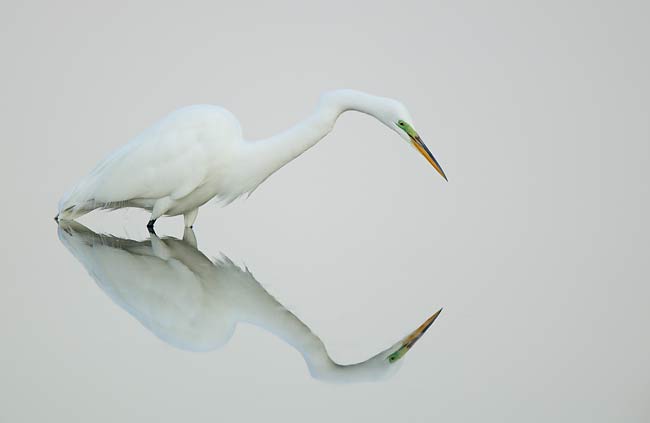
Great Egret, Fort DeSoto Park, FL
Image copyright 2004 Arthur Morris/BIRDS AS ART
Canon EF 500m f/4 L IS lens with 1.4X II TC and EOS 1Ds digital camera. ISO 250
Evaluative metering +1 2/3 stops: 1/400 sec. at f/5.6
Give me water like mercury, and I will gladly include the whole bird's reflection.
Notice that I needed to add 1 2/3 stops of light to come up with the exposure that I wanted.
Here is what the histogram looked like:
Remember, whites to the right!
LESSON #2
Laughing Gull, Fort DeSoto Park, FL
Image copyright 2004 Arthur Morris/BIRDS AS ART
Canon EF 500mm f/4 L IS lens with 2X II TC and EOS 1Ds digital camera. ISO 250. Manual mode: 1 /400 sec. at f/11.
The correct exposure was determined by interpreting the histogram.
This one looks like a fine image, but the bird's head is turned about one degree away from the film plane. Compare this one with the image below:
Here, the bird's head is turned a bit towards the camera and the results are far more dramatic. I took the time to clean the bill and to clone out a few tiny whitish feathers in Photoshop. To learn more about head-angle, light-angle, and subject-to-film-plane orientation, click here:
FORT DESOTO SMALL GROUP/INSTRUCTIONAL SLOTS OPEN: SAT APRIL 3
If you would like to join me for a day of photography and In-The-Field Instruction on Saturday, March 3 at Fort DeSoto just south of St. Petersburg, FL, please e-mail or call (863-692-0906) ASAP for details.
Forster's Tern, Fort DeSoto Park, FL
Image copyright 2004 Arthur Morris/BIRDS AS ART
Canon EF 500m f/4 L IS lens with 2X II TC and EOS 1Ds digital camera. ISO 400.
Manual mode: 1/400 sec. at f/16.
The correct exposure was determined by interpreting the histogram.
Nothing beats getting right on the ground for making intimate, eye-level images of birds. To learn more about ground-level photography, click here:
See info on the Panning Ground Pod at:
DESPERATELY SEEKING SINGLES: THE KENYA PHOTO SAFARI, AUGUST 2004
Todd and I now have four couples signed up for this incredible safari. We are desperately seeking some single photographers to round out the safari: August 24-Sept 7, 2004--15 days on the ground: $6500/person. Single supplement: $1200. Airfare is not included. We can offer a $200 to the first single to join us. Participants need to be in Nairobi at 9am on Tuesday 24 AUG. Lake Naivasha Country Club, Lake Nakuru, Samburu, & Maasai Mara. For additional details on this trip click here: Kenya Photo Safari
To see a spectacular portfolio of co-leader Todd Gustafson's Kenya images, click HERE.
LESSON #3
Reddish Egret, white phase, Fort DeSoto Park, FL
Image copyright 2004 Arthur Morris/BIRDS AS ART
Canon EF 500m f/4 L IS lens with 2X II TC and EOS 1Ds digital camera. ISO 400.
Evaluative metering +1 stops: 1/100 sec. at f/8.
Knowing the natural history of your subjects is a huge plus. Knowing that Reddish Egrets are looking pretty snazzy in late March/early April allowed me to be in the right place at the right time... As the light begins to fade, digital users can simply increase the ISO setting to allow for faster shutter speeds. IS allows me to make sharp images at 1000mm while using very slow shutter speeds like 1/100 second... No sun? Add one stop or more to keep a white wall white!
IPT UPDATES
The June 2004 Nome IPT is sold out.
Fort DeSoto/Sarasota, FL IPT: 3-DAY ($829) MAR 26-28, 2004 is also sold out.
The St. Augustine Alligator Farm, FL IPT: 3-DAY ($829) APR 23-25, 2004 has six openings.
The Point Pelee Warbler IPT: 3-DAY ($829) MAY 9-11, 2004 has six openings.
The Magee Marsh, Toledo, OH Warbler IPT: 3-DAY ($829) MAY 14-16, 2004 is wide open.
Bosque Del Apache NWR, NM. Geese and cranes. 3-day IPTs ($849) NOV 21-23 and NOV 27-29. 2004. Ellen Anon will be co-leading both of these trips with me. (Limit: 14) Both of these IPTs are beginning to fill.
SW FLA ITPs
POST X-MAS: DEC 28-30, 2004, 3-DAY: $869 (Limit 12)
PRESIDENTS HOLIDAY IPT: FEB 18-22, 2005, 5-DAY: $1399 (Ellen Anon will assist me as co-leader on this IPT and conduct a Photoshop session) Amazingly, five slots on this IPT are already filled! (Limit 14)
Click here to enjoy the SW-FL IPT Experience.
THESE ARE MY BREAD & BUTTER CANíT MISS IPTs: HERONS, EGRETS, GULLS, TERNS, SHOREBIRDS, OSPREY, BURROWING OWL & BOTH PELICANS. SPOONBILLS LIKELY. FIND OUT WHY FOLKS COME TO FLORIDA TO PHOTOGRAPH BIRDS! WE WILL VISIT DING DARLING NWR, SANIBEL ISLAND, PLACIDA, THE VENICE ROOKERY, CAPE CORAL, AND LITTLE ESTERO LAGOON.
SAN DIEGO, CA
JANUARY 6-9, 2005. 4-DAY: $1299 (Limit: 12) (Ellen Anon will assist me as co-leader on this IPT and conduct a Photoshop session.)
Click here to enjoy the San Diego ITP Experience.
CALIFORNIA BROWN PELICANS IN SPECTACULAR BREEDING PLUMAGE, BRANDT'S (& OTHER) CORMORANTS, WESTERN, CALIFORNIA, HEERMAN'S--ALSO IN SPECTACULAR BREEDING PLUMAGE, & OTHER GULLS. (WE WILL HAVE INCREDIBLE FLIGHT PHOTOGRAPHY OPPORTUNITIES WITH ALL OF THE ABOVE SPECIES). LESSER SCAUP, WOOD, RING-NECKED AND OTHER DUCKS. MARBLED GODWIT, WILLET, WHIMBREL, SURFBIRD, WANDERING TATTLER & OTHER SHOREBIRDS, EVERYTHING AT CLOSE RANGE! HARBOR SEALS & SEA LIONS. DEPENDING ON LOCAL CONDITIONS, WE MAY BE TEMPTED TO MAKE THE EARLY MORNING TRIP TO BOLSA CHICA LAGOON.
LESSON 4
Sun at sunset over the Gulf, Fort DeSoto Park, FL
Image copyright 2004 Arthur Morris/BIRDS AS ART
Canon EF 500m f/4 L IS lens with two, that's right, two 2X II TCs and the EOS 1Ds digital camera. ISO 400. Evaluative metering: 1/640 sec. at f/8.
To produce dramatic images of a muted sun at dawn or dust, do not hesitate to stack two 2X TCs. In view of the fact that I have twice dropped a TC into the water, I always travel with two sets--two 1.4X TCs, and two 2X TCs. I do so because the TCs are vitally important to the work that I do. If you own a digital camera with a multiplier effect, the 2XII on the lens with the 1.4X II behind it will produce similar results. Those with the older TCs will need to mount a 12mm extension tube between the two TCs.
Best and great picture making to all,
Artie
